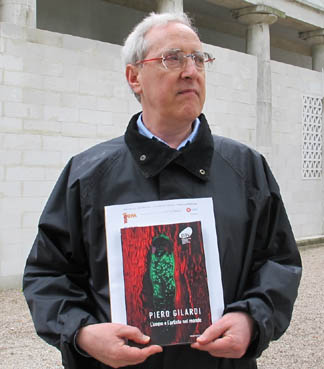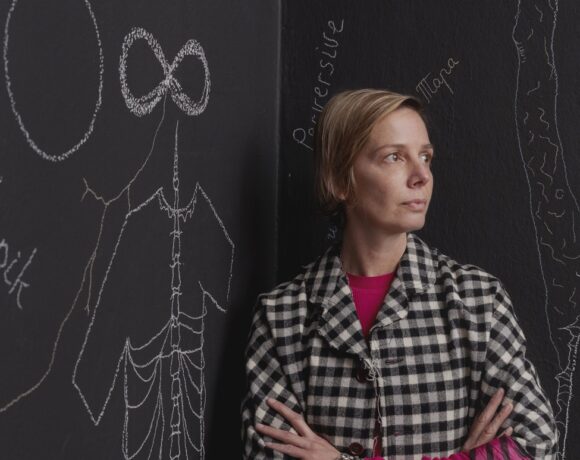From the primordial broth to the Venetian province: this is also a possible path. But Veneto is not only Venice, with the Biennale (an institution that after the dark years following 1968 has become a real queen of international level), or with Punta della Dogana (the power to enthrall with works of big dimensions exhibits in suitable spaces, often by authors who belong to the margins of the Western world): Veneto is also made up of private galleries that act in synergy with the market (see Studio La Città in Verona and Michela Rizzo, in Venice, just to to give two examples) and by a myriad of cultural associations and men of good will acting in the streams of a microscopic and magmatic diffusion.
With Boris Brollo, of precise Venetian origins, we talk about his personal story and about the art system, today, in the period of the Covid-19 epidemic.
Your journey in the art world begins in the 1980s, with Crossing. In that space, in the historic center of the city of Portogruaro and a few steps from the Osteria “I 3 scalini”, you have organized exhibitions by authors such as Claudio Massini, Pierluigi Pusole, Ernesto Jannini, Piero Gilardi, Bartolomeo Migliore, Joan Descarga, Ferruccio D’Angelo… Can you tell us something about those years?
My artistic experience is linked to my socio-political background: first like a student with the priests then like a young communist who immigrated to Milan in 1961. Evening art studies and then a diploma in the Venice Academy with masters Bruno Saetti and Carmelo Zotti. Therefore nothing is more logical than opening a Lab/Art cooperative. From there, after about ten years, I moved on to the Portogruaro Crossing: a group of supporters with Antonio D’Alisa as President and myself as artistic director. First trips to Barcelona, where I met Brossa, Barcelò, Descarga and took the Barcelona Artificial Pintore exhibition to Malo, at Giobatta Meneguzzo’s Casabianca, in 1986. I had already done Kaos, from Alfa to Omega with Grazia Terrible (1985). Then the Germans of the D.D.R. in Montagnana (PD), with the support of Piccinini Gallery in Cortina: I Prolegomeni, looking at Goethe, and with a text by Günter Grass (1987). In 1988, in Auronzo, I made, with the collaboration of Flaminio Da Deppo, Koinè a Nordest with Giardini, Massini, Jannini, Astore, Ragalzi and the older Federico Chiecchi. Then, Grenzgänger: a cycle of exchange exhibitions with Aldemar Schiffkorn responsible for the Government of Upper Austria (1990). These experiences were the Crossing roots, an association with which I plunged into discovery of many young artists such as Walter Bortolossi, Carmine Calvanese, Silvano Tessarollo, Vinicio Momoli, Reinhold Rebhandl, Harald Gsaller, just to name a few. Important for my training in the field of art was the friendship with Berto Morucchio, Venetian critic of Guidi and Arturo Martini, and friend of Tancredi, and who from 1962 to 1966 was secretary of the Marzotto Prize, under the presidency of Pierre Restany. 151 years after the foundation of Marzotto company, count Paolo gave me the opportunity to follow and curate, together with the architect Flavio Albanese and the critic Virginia Baradel, a historical exhibition of that Prize which was an immersion with Belgian, French, and European painting of the Fifties and Sixties.
Very fascinating was the extra issue “Amazonas” conceived by you in 1989 and released in 1990, with the photos of the Guaranì Indians by the missionary Don Grossa, linked with famous authors such as Baselitz, Paladino, Beuys… In the same issue is published again the manifesto on Integralismo Naturale (1979) by Pierre Restany. An operation that certainly anticipated a certain anthropological phenomenology, given that China was still far from the centralized thought of the European collector and Magiciens de la Terre (1989) had just been conceived.
As Warhol used to say, the idea is in the air. Jean-Hubert Martin had been traveling the world for three years to bring together the artists of Magiciens de la Terre, but Restany had already posed the problem with the Amazon Shock by doing forty days on a boat without technological tools and going from Manaus to Rio Grande, leaving it upset and proposing a new relationship with Natural Nature and not shaped by the industrial revolution. Thus a new, pre-ecological thought began, which looked at the mind and the change of the artistic spirit. A change of thought leads to a respect for Nature, and art could very well lend a hand on this. So, when I made Amazonas, Restany could not be missing, and he had been contacted by the late friend Tiziano Santi. Later, with Tiziano Santi, close to Achille Bonito Oliva’s 1993 Biennale, I produced a booklet that collected a selection of the opinions of international critics on the exhibition and this to disavow the attacks of “Flash Art” on the contents of the exhibition.
Later you started some underground duets with Giancarlo Politi and then from these exchanges you have drawn a book. Can you tell us a few words about this strange project?
In those years I had adopted the green slogan: “Think globally and act locally!” So I reread art. And I found some answers in Giancarlo Politi’s Rubric of letters to the editor in Flash Art. Obviously, at first I wanted to measure myself and so I sent the letters anonymously and also with a pseudonym. In the end, one day, in the Flash Art headquarters in Milan, while I was negotiating an advertisement, I revealed myself and continued to write to him throughout the Nineties. Giancarlo has always published and also responded strongly. For me it was a real gym and I saw twenty-five letters published. Later I collected them in a small book and Giancarlo Politi still honors me with his friendship.
What about your relations with Achille Bonito Oliva?
With Tiziano Santi and Ennio Bianco I curated a series of exhibitions in Veneto (Malo, San Donà and Castelfranco) which were supposed to be preparatory to an exhibition linked to the Achille Biennale. They were all titled “1 X 1”, where a critic presented an artist, and at the inauguration they were all honored by the presence of Achille Bonito Oliva. Then I called him for the 7th Sharjah Biennial of the United Arab Emirates, curated by the Palestinian Jack Persekjan, where Achille wrote a text for the catalog with Kamal Boullata and me.
The Triveneto is a territorial reality full of collectors: can you make a “portrait” or give a definition of this reality?
In the Triveneto there are great collectors, but I also think that there have been great “search engines”, such as the Marzotto Prize which saw the participation of the greatest artists of the Cobra Group, the French Informal and the Nouveau Réalisme. Also thanks to the Marzotto Prize, the English artists, led by Norman Rosenthal, arrived in the Vicenza area. All this then gave birth to the Casabianca in Malo. The same goes for Enzo Ferrari’s gallery (Verona) that proposed Manzoni and Yves Klein with the contribution of Guido Le Noci from Milan. Later, Francesco Conz came with the Wiener Aktionismus, and with Francesco I worked for two years. Even earlier in the 1950s in Venice there was the Peggy Guggenheim from 1948, but alongside the Naviglio by Renato Cardazzo with Sam Francis, Lucio Fontana, Georges Mathieu. The Circolo fotografico La Gondola of the Fifties with Ferruccio Leiss was among the first to exhibit photography. Therefore, today, there is no doubt that galleries such as Marina Bastianello of Mestre and Michela Rizzo of Venice do a truly remarkable job.
So, we can say that private galleries of the Triveneto are at the height of this complex and widespread reality?
The world of art has changed and there is no longer a strong link with the territory. Everything takes place above us and the seats are already assigned. On the occasion of its 25th anniversary, Taschen, in 2009, published the list of 100 Contemporary Artists and the Italian artists did not even reach ten.
You are currently director pro-tempore of the Municipal Gallery Ai Molini in Portogruaro and of the M.A.C.A. of Acri (CS). Can you tell us about some future projects that you have standing with the public authority?
It is difficult to talk about the future because there will be elections shortly and as you well know in our country everything is back to the starting blocks. I can remember that, in the manner of the French regional museums, in Portogruaro, on behalf of the Municipality, I recently set up SPACE. The structure (a disused school in Lugugnana) is located on the road called the Triestina Bassa that goes from Jesolo to Trieste, and houses the works of about one hundred and fifty artists, and a Permanent Gallery dedicated to the futurist fellow citizen Luigi Russolo.
In the times of Covid did you encounter difficulties in managing your projects?
I had more time to think about the uselessness of many things and our fragility. And this in the light of an upcoming exhibition that, together with Alessandro Maganza, I will sign for the Concordiese National Museum of Portogruaro dedicated to Fausto Delle Chiaie, a painter who exhibits his own museum every day near the Ara Pacis, in Rome, staff by recycling waste of all kinds.
And with the Venice Biennale do you have any projects on your feet?
The Architecture Biennale that was to be held this year has been postponed to next year due to the Coronavirus epidemic. As a Collateral Event, together with Lucia Tomasi, Cesare Serafino and Giancarlo Caneva, I will organize Senza Terra / Pomerio la zona sacra del vivere civile, with the participation of 45 artists. I am also pleased to recall the 2016 project when I organized the first Senza Terra on the Island of San Servolo, where a bench and a balloon marked a meeting point for any human being who needed to stop, talk, feel like a community.
 Boris Brollo (right) with the French gallerist Patrick Bedout
Boris Brollo (right) with the French gallerist Patrick Bedout
 Exhibition at Mulini di Portogruaro: Biagio Pancino, Biblioteche 1985-2018, ph courtesy Comune di Portogruaro
Exhibition at Mulini di Portogruaro: Biagio Pancino, Biblioteche 1985-2018, ph courtesy Comune di Portogruaro
 View of SPACE Mazzini in Lugugnana, with the sculpture by Andrea Vizzini, ph courtesy Comune di Portogruaro
View of SPACE Mazzini in Lugugnana, with the sculpture by Andrea Vizzini, ph courtesy Comune di Portogruaro
 Senza terra, San Servolo, collateral event at Biennale Architettura (2016), ph di Mireya
Senza terra, San Servolo, collateral event at Biennale Architettura (2016), ph di Mireya
 Boris Brollo (right) with Artan Shabani, Director of the National Gallery in Tirana (2015)
Boris Brollo (right) with Artan Shabani, Director of the National Gallery in Tirana (2015)

He is editorial director of Juliet art magazine.






NO COMMENT